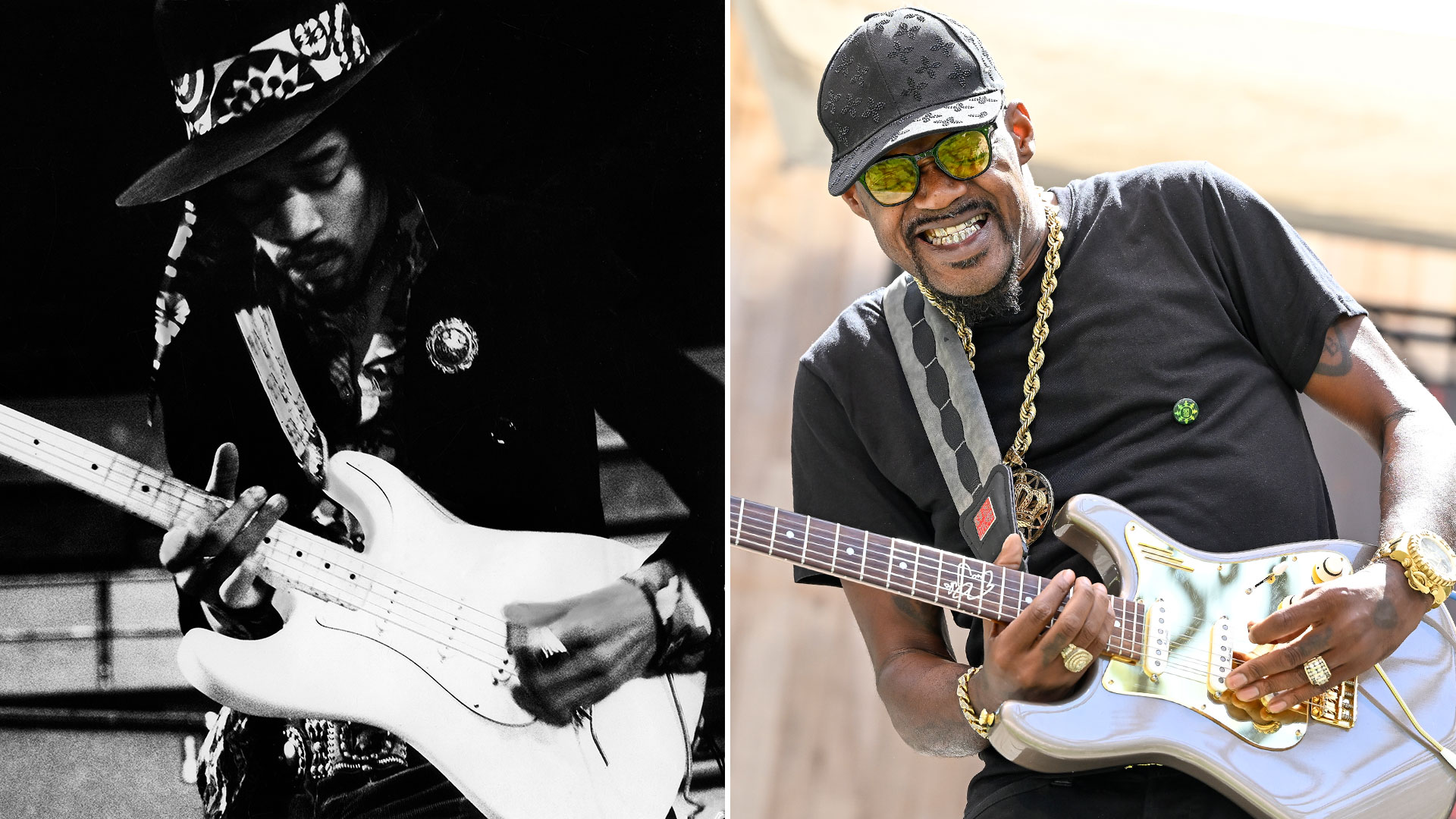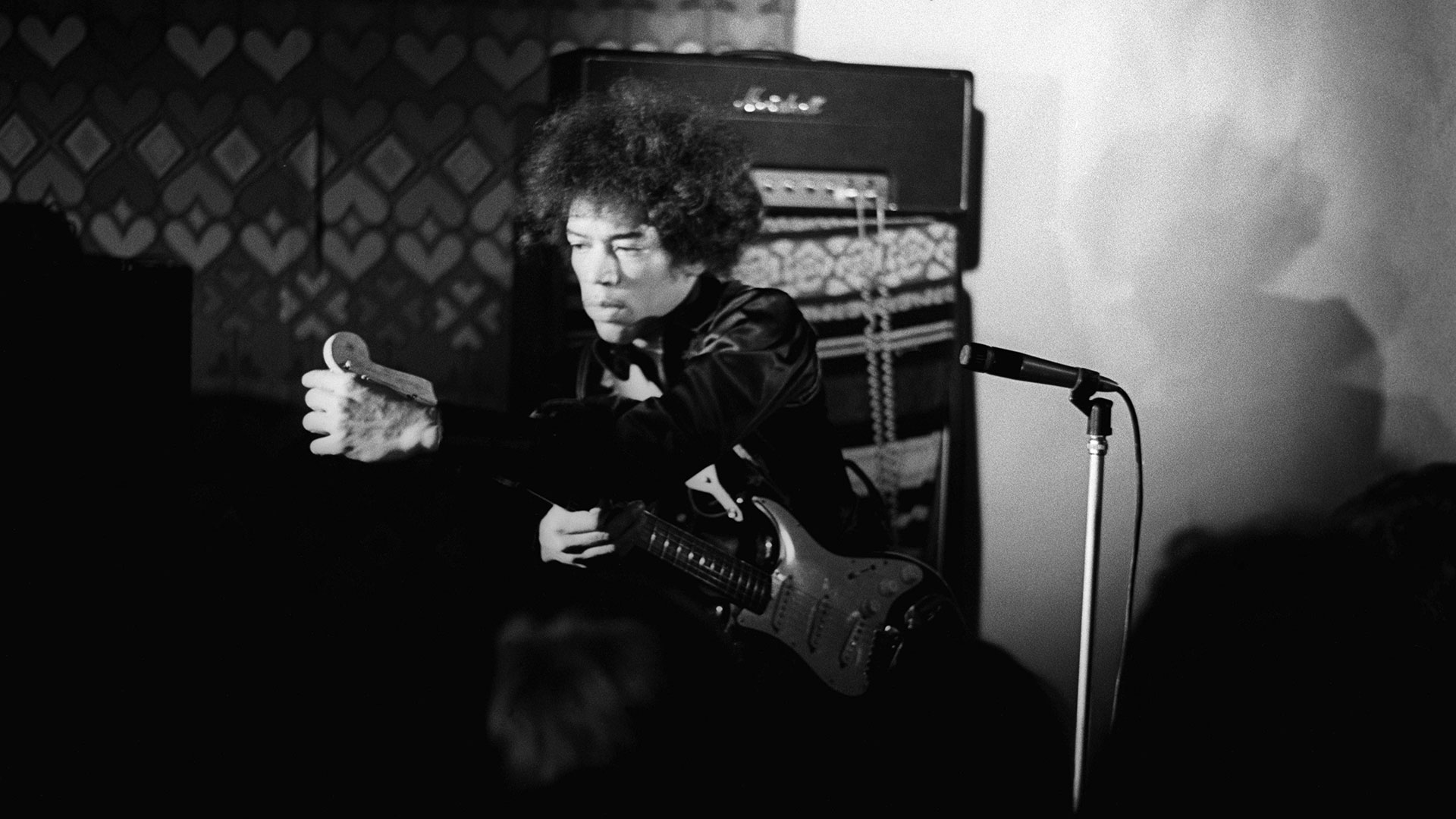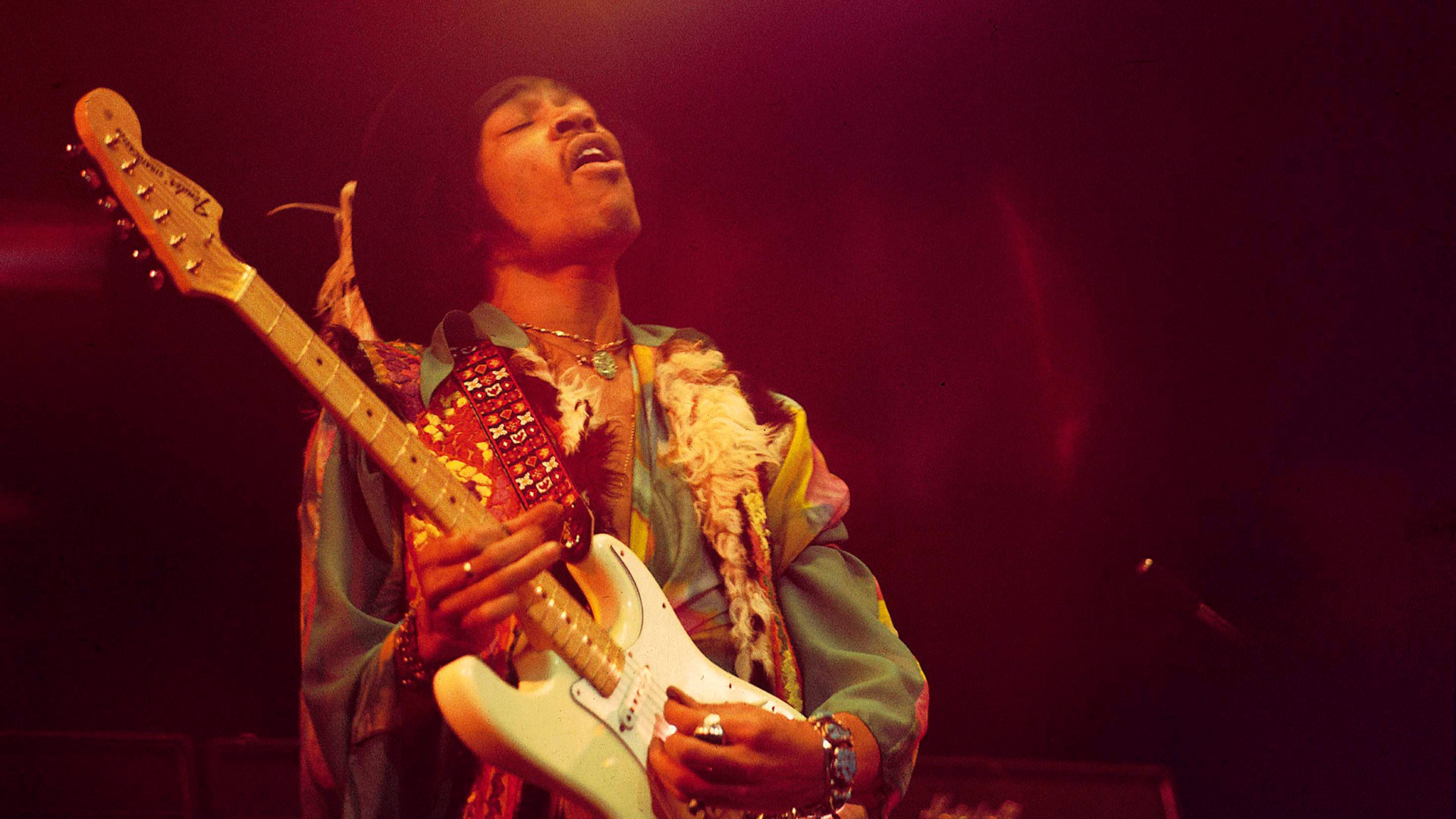“A lot of kids think drop-tuning is this new thing that just came out and it’s like, ‘No way, Jimi Hendrix was doing that stuff a long time ago!’” Eric Gales on the lasting influence and innovations of the ultimate electric guitar icon
Gales says he wears his Hendrix influence with pride. Here, one of today’s greatest blues-rock guitarists shares his insight on the visionary and fearless experimentalist

The most influential guitarist of all time, Hendrix was an innovator and visionary whose pure artistry was expressed with fearless experimentation
Eric Gales is no stranger to innovation. Over the past three decades he has managed to redefine the language of blues guitar with flair and finesse, drawing from all kinds of genres, styles and sounds to create a unique musical identity.
In that regard, before you even factor in how Eric ended up using right-handed Strat-style guitars upside down, there are many comparisons to be drawn between him and Jimi Hendrix.
Eric naturally counts Hendrix as one of his biggest influences alongside Eric Johnson, Stevie Ray Vaughan and Albert King. Here, he discusses why Jimi will never be topped in the annals of guitar greats…

When you hear the name Jimi Hendrix, what are the first things you think of?
“It’s all about innovation. Jimi Hendrix was able to find new sounds by just sitting down and experimenting on his own. He found all these different techniques that seemed to work for him, things like using his thumb for bass notes over the neck.
He was able to accomplish whatever he was hearing in his head. And it feels like he never gave up – that guy would do whatever it took to make it happen!
“He had big hands so he was able to use his own physicality to help him accomplish whatever he was hearing in his head. And it feels like he never gave up – that guy would do whatever it took to make it happen! It’s almost impossible to comprehend just how innovative he was and how he ended up influencing me.
Get The Pick Newsletter
All the latest guitar news, interviews, lessons, reviews, deals and more, direct to your inbox!
“I’d actually say there’s nothing he did that didn’t influence me – from his legendary tone to the way he used chords to writing and everything else. I could sit here all day long trying to explain his contributions to the world in terms of guitar playing, songwriting and even lyrics. He could express himself beautifully.”

Hendrix could draw from deep within, but he was also a shrewd observer – and therefore able to tell the story of the world around him.
“Yeah! Even all these years later, I’m still blown away by the sheer magnitude of how Hendrix was able to communicate and talk about things that were happening in his era, in his time. He was telling us about the world around him, and it was in a terrible state. He would channel all of that frustration and anger into his guitar.”
Which probably explains why his Strat could sound like bombs going off and missiles shooting down from above…
“He was trying to emulate things that were going on during his time. It was an expression of mayhem, chaos and turmoil and what an awesome translation it was.
Let’s not forget the beauty he saw in the world around him too – which you can hear on tracks like Little Wing and Angel
“When you read up on his life, you get an understanding of his backstory and it becomes clear he was trying to recreate the destruction from all the way and the uneasy state of the world at the time. It’s still going on all these decades later, we got a whole lot of chaos going on right now.
“Hendrix was translating the human experience through his guitar, from the eyes of all these different people across the world. But let’s not forget the beauty he saw in the world around him too – which you can hear on tracks like Little Wing and Angel.
“He was able to channel a delicate side that focused on his love for the people in his life and everything that inspired the beautiful sounds and colors in his mind. From his mind to his instrument to the studio speakers and finally the ears of the listener, it was pure poetry and not a task for the faint of heart. He was brave, beautiful and powerful.”
Little Wing and Castles Made of Sand are great examples of how he was able to play rhythm and lead at the same time, playing licks within the chords…
“In my opinion, that kind of stuff came from his Curtis Mayfield influence and what he took from the soul and R&B genres. He would take some of those more gospel-style lines and experiment, twisting them in his own way. It led him down the road of finding songs like Little Wing and Castles Made Of Sand.
“That’s why he was such a big part of the guitar’s evolution. He was doing things that had never been done. And we’re supposed to try and evolve this thing – anyone that’s influenced by me will automatically end up taking on the players that inspired me and turn it all into something new.”

In that respect, he was the most innovative force in the history of electric guitar…
“I don’t even think he was aware of his skills and the impact he’d end up leaving on this world. He was doing things that hadn’t been done prior to him, but of course he was also taking his own influences and molding all of them into his own unique character.
A lot of these new kids think drop-tuning is this new thing that just came out and it’s like, ‘No way, Jimi Hendrix was doing that stuff a long time ago!’
“Inspiration is very, very powerful and can lead you into a room with the door closed for days. You will be sat there trying to emulate all these magical noises made by the people you are influenced by and it will take you in a new direction, quite often by randomly trying stuff and making a few mistakes along the way.
“That’s how it worked for me. So I’d listen to songs like Bold as Love, Remember and If Six Was Nine, trying my best to jam along to them. I also loved a lot of the lesser-known tracks like Peace in Mississippi.
“It’s easy to forget this guy was experimenting with serious drop-tuning way back then. A lot of these new kids think drop-tuning is this new thing that just came out and it’s like, ‘No way, Jimi Hendrix was doing that stuff a long time ago!’
“All these different approaches and techniques were the sound of him getting the noises out of his head and onto the fretboard and ultimately through his amp cabinet. He’d intentionally bust his speakers to create distorted sounds. He had no boundaries when it came to trying things.”
It’s interesting how similar words have been used to describe your own playing…
“I’ve often questioned myself about my own reckless abandon and a lot of that comes from Jimi. Basically, you’ll never know if you don’t try. That’s one of the most important lessons I learned from him. And who would have the guts to try all this stuff during a live show, not knowing what might happen next?
“He was the one to say, ‘Alright, I’m playing this guitar and you will all know who I am!’
“I try to be like that myself. If I hear it, I’ll try to strike while the iron is as hot as it can be. You’ll never know what might happen until you try. I have a habit of executing things like that on the fly just like Hendrix did. He was always off-the-cuff. Every night was different. No solo was the same.
“That’s another thing I really learned from – make every night stand out and feel like that night! There was no stone left unturned when it came to unlocking the ideas in his head. And he made you pay attention.
“He was the one to say, ‘Alright, I’m playing this guitar and you will all know who I am!’ It’s like he came from this whole other planet. He was so ahead of his time, even now you listen to his recordings and they sound like something new and exciting.”

There’s also another connection because you’re both left-handed players who ended up using right‑handed Strat-style guitars upside down.
“I agree. During Hendrix’s time, there weren’t a whole load of examples to go from. His technique and style was pure trial and error. He figured it all out on his own. There were no how-to books, YouTube videos, tablatures or anything like that. It was all nose-to-the-grind sitting down and conjuring up whatever he could. And boy, did he come up with some stuff!
“So there are similarities to me, in that sense. I didn’t grow up with a whole lot of examples, either. All the people I was influenced by were right-handed players. I wasn’t even paying attention to what way they were playing. I just knew I liked what I heard and I refused to quit until I figured it out.”
Which of your songs do you think ended up drawing more from that Hendrix influence?
I don’t care who you are, no matter what style you play, Hendrix will have influenced you somehow
“Roughly 19 albums in, I can say there are plenty of conscious and nonconscious things I do directly out of the Hendrix book. I’d be the first to admit it and I’m not embarrassed to say it! I don’t care who you are, no matter what style you play, Hendrix will have influenced you somehow.
“But off the top of my head, there are some chordal things I do in the song Stand Up from my most recent record [2022’s Crown] that you can link to his work on Axis: Bold as Love, especially songs like Castles Made of Sand.
“There’s also a heavier kind of influence on my song Survivor which has a If Six Was Nine sort of style to it. I’m sure there are a handful of songs on every record I’ve done that will have come from Hendrix’s world.”
It says a lot that 56 years on from the release of his debut album, he’s still influencing us and considered the greatest guitar player of all time…
“It does! And I think it’s because he was hearing all these things in his head and would do whatever it took to make it come out of his fingers. There were no limitations – that’s what led to a lot of innovative things that still has the world with a huge question mark hanging over our heads, asking ourselves how and where the hell did this all come from?
“Until the end of time, we’re going to be wondering how this guy came up with this stuff. Why did he play like that? What was he thinking? I don’t have the answers… I just know I enjoy listening to his genius.”
- Eric Gales’ latest album Crown is out now.
Amit has been writing for titles like Total Guitar, MusicRadar and Guitar World for over a decade and counts Richie Kotzen, Guthrie Govan and Jeff Beck among his primary influences as a guitar player. He's worked for magazines like Kerrang!, Metal Hammer, Classic Rock, Prog, Record Collector, Planet Rock, Rhythm and Bass Player, as well as newspapers like Metro and The Independent, interviewing everyone from Ozzy Osbourne and Lemmy to Slash and Jimmy Page, and once even traded solos with a member of Slayer on a track released internationally. As a session guitarist, he's played alongside members of Judas Priest and Uriah Heep in London ensemble Metalworks, as well as handled lead guitars for legends like Glen Matlock (Sex Pistols, The Faces) and Stu Hamm (Steve Vai, Joe Satriani, G3).
Guitar World Discussion: Who is the most underrated guitar player of all time?
Ozzy Osbourne’s solo band has long been a proving ground for metal’s most outstanding players. From Randy Rhoads to Zakk Wylde, via Brad Gillis and Gus G, here are all the players – and nearly players – in the Osbourne saga











